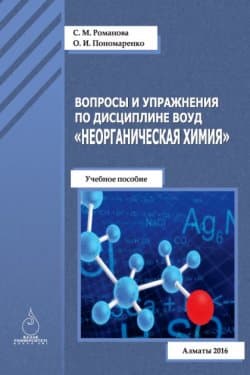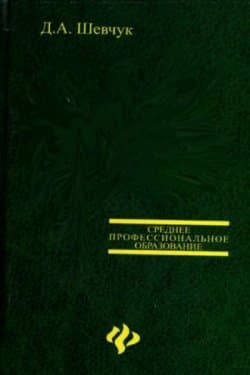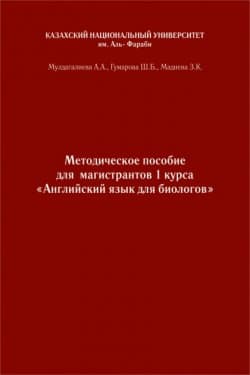Английский язык. Учебно-методическое пособие к практическим занятиям для биологов бакалавриата и магистратуры - З. Мадиева, Шолпан Гумарова, Айжан Мулдагалиева (2003)
-
Год:2003
-
Название:Английский язык. Учебно-методическое пособие к практическим занятиям для биологов бакалавриата и магистратуры
-
Автор:
-
Жанр:
-
Серия:
-
Оригинал:Английский
-
Язык:Английский
-
Издательство:КазНУ
-
Страниц:6
-
Рейтинг:
-
Ваша оценка:
Сборник произведено из приспособленных и уникальных слов. Любой задание подключает слово для интенсивной переработки и слово для устного и письменного перевода. Разработан лексико–грамматический ткань, серия упражнений к словам и деятельный лексика. В конце дан вспомогательный ткань – уникальные слова из британских и американских источников и Онлайна для подготовки отчетов и написания рефератов. Пособие разрешает купить способности чтения и перевода особой литературы, освоить терминологию и взростить устную речь. «То, собственно что неувязка загрязнения находящейся вокруг среды и экологии стала самой необходимой для населения земли, бесспорно для всех. Чем более развивается культура, что острее делаются экологические трудности. Загрязнение воздуха, воды и земли индустрией в реальное время добивается больших масштабов. Он ломает находящуюся вокруг среду в большущих городках. Воздух загрязняют в ведущем системы отопления и авто. Вы понимаете, какой трафик в большущих городках. Чем медлительнее перемещение, что более выхлопных газов.
Английский язык. Учебно-методическое пособие к практическим занятиям для биологов бакалавриата и магистратуры - З. Мадиева, Шолпан Гумарова, Айжан Мулдагалиева читать онлайн бесплатно полную версию книги
The Aral Sea is located among the deserts of Central Asia. A terminal lake (i.e., without surface inflow ), its level is fundamentally determined by the balance between surface inflow from two large rivers and net evaporation ( i. e. evaporation from its surface minus precipitation on it), which is estimated to be around 874 mm per year. Net ground water exchange plays a secondary role and data on it are approximate.
Five former republics, now independent nations, lie wholly or partially in the sea's basin: Uzbekistan, Kazakstan, Kyrgyzstan, Turkmenistan and Tadzhikistan. The Aral Sea drainage basin encompasses all of Uzbekistan and Tadzhikistan, all but the nothern part of Kyrgyzstan, the eastern half of Turkmenia and the two southern oblasts of Kazakstan. It also includes part of nothern Iran and Afganistan. The flow of the Amu-Dar'ya arises primarily from the Pamir Mountains and the flow of the Syr-Dar'ya primarily from the Tien-Shan Mountains. The population of that part of the Aral Sea basin lying in the former Soviet Union was around 35 mln in 1990.
The Aral Sea was the world's fourth largest lake in the area in 1960. Although somewhat saline the lake was populated mainly by fresh water species and had a productive fishery as well as serving as a major regional transportation route. The vast deltas of Amu-Dar'ya and Syr-Dar'ya not only had major ecological significance, with a diversity of floral and faunal species but great economic importance related to irrigated agriculture and animal husbandry, hunting and trapping, fishing and harvesting of the reeds that grow in abundance in the numerous wetlands and lakes found here.
Over the past 40 years the sea has steadily shrunk. The reason is a huge and growing diminuation of discharge from the Amu-Dar'ya and Syr-Dar'ya, caused primarily by the expanding irrigation in their basins.
Irrigation expantion in the Aral Sea basin after 1960 required much more water per hectar as long canals were extended into the desert; poorer, more saline soils were irrigated, requiring heavier water applications. Giant reservoirs were built that required filling and which increased evaporative losses, and new irrigation systems discharged their water into the deserts rather than back to the rivers.
The net result has been an increasingly large difference between the gain (river inflow) and loss (net evaporation) sides of the sea's water balance. Consequently, the drying, recession and salingation that began in 1960s, accelerated in the 1970s and 1980s and continues into 1990s.
In 1987 the Aral Sea divided into two water bodies: the smaller sea in the north and the larger one in the south. Since then, these have developed as separate water bodies with their own water balances. The Syr-Dar'ya flows into the small sea, whereas the Amu-Dar'ya enters the large sea. A connecting channel existed between the two until mid 1992 when it was blocked by a dike to prevent further water loss from the small to the large sea.
The water body will continue to shrink rapidly because net inflow to it, consisting of surface and subsurface compounds, will remain well below net evaporation. By 2005, when the level falls to 30 m the large sea will separate into a deep western part, which would continue to recede and salinize since it would receive no surface inflow, and a shallow eastern portion which would shrink and salinize less rapidly since it would continue to receive inflow from the Amu-Dar'ya. The eastern part of the large sea would stabilize with an area around 7000 sq km later in the century.
EXERCISES:
1. Translate the following into English:
 Вопросы и упражнения по дисциплине ВОУД «Неорганическая химия» София Романова, Оксана Пономаренко
Вопросы и упражнения по дисциплине ВОУД «Неорганическая химия» София Романова, Оксана Пономаренко
 Будущее Земли Эдвард Уилсон
Будущее Земли Эдвард Уилсон
 Мировая экономика Денис Шевчук
Мировая экономика Денис Шевчук
 Итальянский шутя. 100 анекдотов для начального чтения Ефремова Мария
Итальянский шутя. 100 анекдотов для начального чтения Ефремова Мария
 Двойня или Чудо в квадрате. Пособие для мам близнецов и двойняшек Ольшевская Анастасия
Двойня или Чудо в квадрате. Пособие для мам близнецов и двойняшек Ольшевская Анастасия
 Грамматика киноязыка Арижон Даниэль
Грамматика киноязыка Арижон Даниэль

 Пир теней
Пир теней  Князь во все времена
Князь во все времена  Когда порвется нить
Когда порвется нить  Пока я здесь
Пока я здесь 



